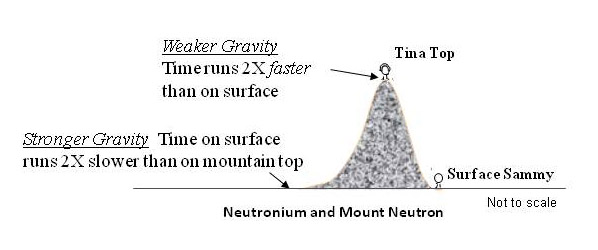You see, assuming identical clocks, the lower clock (lower altitude) always runs slower than the higher clock (higher altitude). Why? Because the lower clock is closer to the source of gravity, the Earth. This effect is extremely tiny here on our small planet. That’s why we don’t notice it. But it is real!

How do we know? Physicists at the National Institute of Standards and Technology (NIST) recently used two super-accurate aluminum ion clocks to test Einstein’s wild idea. They placed one clock about 6 inches above the other. The lower clock indeed ran a tiny bit slower than the higher clock; and in just the amount predicted by Einstein’s formula! This came as no surprise to scientists. All previous tests showed the same effect — atomic clocks at sea level ran slower than identical clocks on mountains, airplanes, rockets, and satellites.* Gravity does slow down time.
What does this have to do with time travel? It means we can (and do) travel forward and backwards through time. And we don’t have to climb into some imaginary time machine to do it; we just need to change altitude.
The Twins Paradox and Gravity
To get a feel for how this works, imagine a fictitious super-massive, super-dense stellar object called Neutronium. On its surface is a mountain of great height called Mount Neutron. Now gravity on the surface of Neutronium is much stronger than gravity on the mountain top. So much so that time on the surface runs twice as slow as time on Mount Neutron. So, for every year that goes by on the surface of Neutronium; two years go by on the mountain top.
Say twins are born on the surface and separated at birth. One is immediately sent to live on the top of Mount Neutron. Let’s call her Tina Top. We’ll call the remaining twin Sammy Surface.

On her 30th birthday, Tina Top decides to leave Mount Neutron and visit her twin brother on the surface. But when she arrives down below, Sammy Surface is only 15 years old. After all, time for Sammy has run at only half the rate of time for Tina on top of that mountain.
Say the twins were born in the surface year 2000. Tina Top returns to Sammy in the surface year 2015. But 30 years have gone by for Tina. To her, it should be the year 2030, but it is only the year 2015 here on the surface. Do you see it? Tina Top has effectively traveled 15 years into the past.
Now say after visiting Sammy Surface, Tina Top immediately returns to Mount Neutron. Then on his 30th birthday, Sammy Surface travels to Mount Neutron to visit his twin sister. When he meets Tina, she is now 60 years old. In fact, everything on the mountain-top has aged 60 years since they were born.
Sammy spent 30 years on the surface, but it is now 60 years later on Mount Neutron. Sammy Surface has traveled 30 years into the future!**
Everyday Time Travel with Gravity
Time on the surface of the Earth runs some 0.02 seconds per year (2 seconds per century) slower than time in the zero gravity of outer space. Again the effect is so small here because Earth’s gravity is relatively weak. But we still experience time travel whenever we change altitude.
I live in a two-story house and my bedroom is upstairs. Gravitational time dilation makes the alarm clock in my upstairs bedroom run a very tiny bit faster than the wall clock in my downstairs kitchen. (Assuming identically accurate clocks.) This effect has nothing to do with the clocks themselves. If I switch clocks, gravitational time dilation still makes the upstairs clock run faster than the one downstairs.
It is time itself which is running faster upstairs. All night long, as I sleep upstairs, all aspects of time are moving ever so slightly faster than time downstairs. For example, my heart beat at rest (all other things being equal) is a tiny bit faster upstairs than down. I am aging a tiny bit faster upstairs. When I come down to breakfast in the morning, I am in effect traveling into the past (by a miniscule amount). Similarly, if I spend my day at ground–level, when I return to my upstairs bedroom at night I am traveling a miniscule amount into the future.
So gravitational time travel is real. We do it all the time. Into the future and into the past. If we wore accurate enough watches, we wouldn’t need to read about this effect. Time travel with altitude would be an accepted gravitational effect, just like the proverbial apple falling from the tree.
* Physicsworld reports that these remarkable devices remain accurate to within one second in 3.7 billion years.
** Effects of time dilation due to motion ignored throughout.
© 2011 Ira Mark Egdall
This article is based on a book I am writing which explains relativity in everyday language. For more details go to:
http://marksmodernphysics.com/
Learn more:
http://www.upscale.utoronto.ca/PVB/Harrison/GenRel/TimeDilation.html
http://hyperphysics.phy-astr.gsu.edu/hbase/relativ/airtim.html



